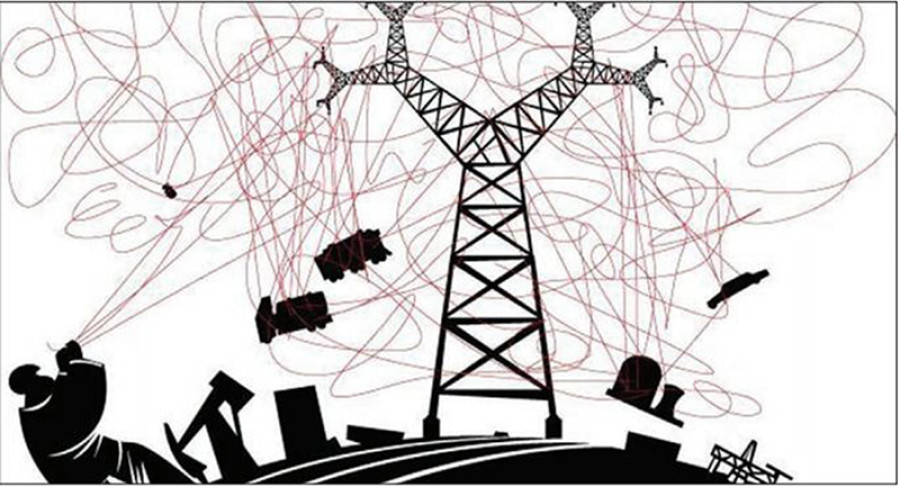Opinion
Cross-border energy trade
With an installed regional capacity of 360,603MW, South Asia is gradually emerging as a fulcrum of electricity exchange and power trading.
Mahendra P Lama
With an installed regional capacity of 360,603MW, South Asia is gradually emerging as a fulcrum of electricity exchange and power trading. Bilateral exchanges are occurring, as evident in the noteworthy Bhutan-India power flow of 1,410MW. The first and historic inter-connection between the Bangladeshi and Indian national grids in 2013 enabling a 600MW exchange is of particular note; it has triggered immense possibilities and opened the scope for multilateral power flows. Nepal could potentially be the biggest beneficiary in this game; if harnessed steadily, its power could be sold across South and South East Asia, with wheeling facilities provided by Indian national grids.
Cross-border energy trade could lead to effective utilisation of natural resources, increase in supply reliability and savings in capital and operating costs. Besides the optimal use of generating capacity and mutual support during contingencies, it addresses seasonality issues both in terms of generation and daily usability. It could also bring about large scale transformation in various sectors. It could be the single most effective confidence-building measure through the participation of multiple stakeholders and consolidate regional cooperation and integration process.
Reinforcing factors
There are several reinforcing factors that are bound to promote energy exchanges among Saarc member countries in the near future. Huge power crises are leading to long hours of load shedding in many South Asian countries. In June 2015, a Pakistani newspaper stated that “a suffocating heat wave across Pakistan has killed over 700 in the past week, exposing a severe power crisis and threatening to usher in a new period of political unrest.” The energy import and deficit costs have been rather disturbing. There has been tremendous public pressure on respective governments to improve the situation.
Saarc leaders seem to be fast realising the criticality of energy cooperation. Islamabad Saarc Summit Declaration (2004) floated the concept of an ‘energy ring’. In the Kathmandu Summit (2014), leaders signed the Saarc Framework Agreement for Energy Cooperation. It provides non-discriminatory transmission access for cross-border electricity trading. Following this, Nepal and India signed an agreement on Electric Power Trade, Cross-border Transmission Interconnection and Grid Connectivity in 2014. They also set up a Joint Working Group for the planning and identification of cross-border interconnection.
There have been protracted sensitisation and preparations at the regional level. The technical and professional organisations responsible for generation, transmission and distribution have met several times to work on both short- and long-term possibilities. The Petrobangla, Bangladesh Power Development Board, Power Grid and Power Trading Corporations of India, and the electricity and regulatory authorities of Nepal, Sri Lanka and Pakistan have become the key stakeholders. International agencies like the World Bank, ESCAP, Asian Development Bank, USAID (SARI-E initiatives) and UNDP have also been fairly active. Several training programmes and capacity-building projects have been conducted at various levels. Many forward-looking and comprehensive studies are in place.
Sector reforms
Though Nepal, Bhutan and Bangladesh are lagging behind, massive power sector reforms have taken place in other parts of the region. The Electricity Act 2003 was designed in India with the aim of developing the power market through increased competition, more players and protection of consumer interests. It recognises trading as a distinct activity and has made adequate and progressive provisions governing open access both in terms of transmission (inter-state and intra-state) and distribution networks. Another policy, the Integrated Energy Policy 2006, recognises that energy security can be increased by diversifying sources of import and energy. It notes that the import of hydro power through Bhutan and Nepal could enhance energy security. The first national level power exchange, the Indian Energy Exchange (IEX) commenced operation in June 2008. It has already attracted more than 200 participants, with 25 states, four union territories, many power plants and direct consumers. This has facilitated trading of more than 6.7 billion units worth Rs45 billion.
In Pakistan, there is a well laid-out commercial framework for independent power producers and fiscal concessions. The National Electric Power Regulatory Authority has been set up as a regulatory body, and the Water and Power Development Authority has prepared a Hydropower Development Plan Vision 2025. However, scheduled power cuts, unscheduled outages and incorrect voltages are common in most provinces of Pakistan, leading to enormous disruptions. The gap between user charges and the cost of supply are intractable issues. Power utilities have been suffering from losses. Pakistan is examining several alternatives and cross-border power trade is the most attractive one.
Traditional debate on what exactly leads to cross border power flows—surplus power generation or pre-established transmission interconnection—has now been examined from various perspectives. Various experiments indicate that laying transmission interconnections early could open up the possibility and scope for power flows in all directions, both within and outside the country. Transmission constraints continue to affect well-established regional power pools such as the 14 member West African Power Pool (WAPP), the 12 member South African Power Pool (SAPP) and the six member Greater Mekong Sub-region. All of these power pools have significant gaps between bids and actual traded volumes in spot markets because of transmission constraints. Such constraints are not seen in power pools like the PJM interconnection in the US and even the Nord Pool in Northern Europe that encompasses the 20 countries.
Massive infrastructure has been developed in the energy sector in South Asia. For instance, the laying of transmission systems in India has led to many inter-state and inter-regional exchanges. The present inter-regional capacity is 38,650MW and is expected to reach 75,000MW by 2017. The 400KV Muzaffarpur-Dhalkebar transmission line between India and Nepal is now ready for operation.
Financial institutions, including multilateral and bilateral agencies, are keen to invest. China and Japan are emerging as new actors in harnessing trans-border energy in the region. For instance, in the $46billion China-Pakistan Economic Corridor Project (CPEC), five projects with a capacity of 1,850MW are already in the works. Japan has started constructing the 1,200MW Matarbari Ultra Super Critical Coal-Fired Power Project in Bangladesh. These could generate surplus power and create the possibility of cross-border exchanges.
CASA project
Extra-regional linkages are fast emerging. For instance, under the Central Asia South Asia (CASA) 1000 project, three to six terawatt hours of hydroelectricity is likely to be transferred from the Kyrgyz Republic and Tajikistan to South Asia during the summer of 2016. Other initiatives like the Turkmenistan-Uzbekistan-Tajikistan-Afghanistan-Pakistan (TUTAP) interconnection with Afghanistan and the buy-back arrangement of 80 percent of the India-funded 1,200MW Tamnthi Damin Myanmar in 2007 add remarkable power exchange dimension.
Pakistan’s import of power from Iran is going to be quite significant. India is opening and extending the market for energy produced in future interconnection and trade projects. These projects bode well for Pakistan, as they are likely to generate more than the projected power demand of 45,000 MW in 2030 (as against the current installed capacity of 22,500 MW). The surplus is bound to be traded in the neighbourhood.
For this to happen, a sub-regional infrastructure investment fund and a sound tariff structure need to be established. Interconnection, common grid code, harmonisation of transmission planning, design, operational practices, and power infrastructure database design and implementation are going to be the core elements of negotiations.
Lama, a high end expert in the Institute of South Asian Studies, Sichuan University, China, has led various South Asian teams in cross-border power trading studies




 16.12°C Kathmandu
16.12°C Kathmandu










